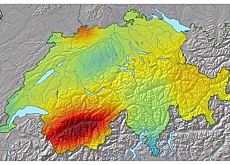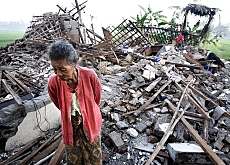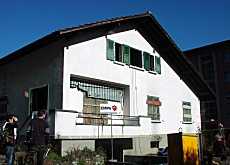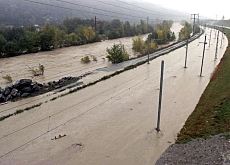Conference highlights earthquake threat

The Swiss government intends to drive home the very real threat of earthquakes in Switzerland and surrounding regions at a conference in Geneva this week.
The five-day meeting, which opened on Monday, has attracted more than 1,000 seismologists and earthquake engineers in what is the first major European gathering of its kind.
According to the Swiss Seismological Service, there have been more than 10,000 earthquakes felt in Switzerland over the past 800 years.
Half a dozen of them have registered more than 6.0 on the Richter scale – all in canton Valais over the past 150 years – and experts say a similar-sized quake is certain to occur in the future.
Two years ago the Seismological Service warned that Switzerland, which lies on the edge of the Eurasian tectonic plate, should expect to be hit by earthquakes up to a magnitude of 7.5 on the Richter scale.
It is estimated that a quake of that size would cause damage of up to SFr60 billion ($49 billion).
“7.5 would be a big earthquake in Switzerland and it cannot be ruled out,” Stefan Wiemer, a research scientist at the Zurich-based Seismological Service, told swissinfo.
“Earthquakes of that magnitude or more likely earthquakes of a somewhat more moderate size – 6.0 or 6.5 – have happened in the past and they will happen again in the future. We’re certain of that. We just don’t know when.”
Early warning systems
“We can’t avoid an earthquake, but we can minimise its effects,” said Swiss Environment Minister Moritz Leuenberger during his opening address.
Leuenberger said a better system of checks needed to be put in place to ensure building norms were adhered to. He also called for the introduction of earthquake insurance with part of the premiums paying for preventive measures.
The conference has a programme of 600 presentations and ten keynote addresses on subjects ranging from dam safety and early warning systems to building design in seismic areas.
“We are lucky enough not to have had too many earthquakes lately but Switzerland is in an earthquake-prone area and we want to hear the experiences of partner countries of what happens when earthquakes occur, what happens to buildings and so on,” said Olivier Lateltin, who heads the Federal Environment Office’s coordination centre for earthquake mitigation.
Safety inventory
Swiss authorities say awareness of the earthquake threat has improved in recent years but is still lacking in some quarters. A new seismic hazard map for the country was published two years ago and building codes were strengthened in 1989 and 2004.
A safety inventory of all federal buildings was begun in 2000 and a programme launched to upgrade those that did not meet standards. The environment office says around a third of Swiss cantons have embarked on similar action.
But Lateltin insists that the threat is still not being taken seriously enough. He says the application of new building norms by architects and engineers remains a “big issue”.
“More than 90 per cent of existing buildings were constructed before the [building] norm was adopted in 1989,” he said.
“I’m not saying that all these buildings are unsafe but we have an unknown security on these buildings in the event of an earthquake of a magnitude between 6.0 and 6.5. From the experiences of our colleagues abroad, we know that one in five buildings might have a problem.”
The environment office has now made it a priority to raise awareness and has recently bought a mobile earthquake simulator that will shortly start touring the country.
swissinfo, Adam Beaumont
The seismic threat to Switzerland is considered moderate to medium. The most exposed areas are Valais, Basel, the Rhine valley in St Gallen and Graubünden.
Situated at the heart of Europe, Switzerland lies on the edge of the Eurasian tectonic plate. The border of this plate – and hence the area of friction with the neighbouring African plate – follows the line of the Alps.
Basel, on the other hand, sits squarely in the centre of the so-called “Rhine rift valley”, a fault in the Earth’s crust which opened up 30 million years ago when the Eurasian continent fractured along a line running from the North Sea to Switzerland.
Experts fear that an earthquake could also trigger tidal waves caused by landslides into the country’s lakes and reservoirs.
In May more than 6,000 people died in an earthquake that measured 6.3 on the Richter scale in Java, Indonesia.
Last October a quake with a magnitude of 7.6 in Pakistan and the Indian Kashmir region left at least 75,000 dead.
The Indian Ocean earthquake on December 26, 2004, had a magnitude of 9.15 and triggered a series of tsunamis, which killed around 220,000 people.
The most devastating earthquake to strike Switzerland happened in 1356 in Basel. It destroyed much of the city. According to historical accounts, between 30 and 40 mediaeval castles collapsed in the hardest hit area.

In compliance with the JTI standards
More: SWI swissinfo.ch certified by the Journalism Trust Initiative



You can find an overview of ongoing debates with our journalists here. Please join us!
If you want to start a conversation about a topic raised in this article or want to report factual errors, email us at english@swissinfo.ch.